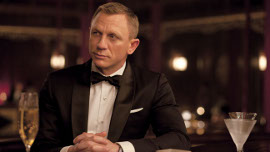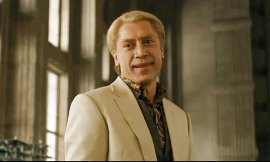 SKYFALL
SKYFALL
Longtime fans of the franchise can, and likely will, argue over whether Skyfall is one of the all-time best James Bond films or whether it just feels that way because it's now been six years since the last decent one. (Despite having friends who'll stump for everything from Moonraker to The World Is Not Enough, I don't know anyone who really cares for 2008's Quantum of Solace.) But here's a question that I'm not sure merits any argument: Prior to this latest adventure, has any other Bond movie looked quite so spectacular?
The agreed-upon answer, I'm thinking, would be "probably not," because for all of the expected and unexpected pleasures in this 50th-anniversary outing with 007, Roger Deakins' gorgeously rendered, utterly sublime cinematography has to count among Skyfall's greatest. As I'm wont to do during globe-trotting spy thrillers, I occasionally found myself mentally checking out of the film's narrative, and there was about a 20-minute passage during the movie's final third - right when the meaning of its title became clarified - when professional obligation was about the only thing keeping me from napping. (And I may not have entirely succeeded on that front.) Yet even when my attention drifted, I was continually knocked out by Deakins' and director Sam Mendes' stunning screen compositions, which are so vibrant that they put the visual design of 2012's other Hollywood blockbusters to shame. Over the years, James Bond vehicles have routinely delivered stuntwork that takes your breath away. Here what does the trick is the lighting.
In a few establishing shots of urban China at night, particularly downtown Shanghai, Deakins photographs the illumination from high-rise windows and the streets' flashing neon advertisements with an evocative expressiveness that makes the city seem both enticing and menacing - ravishing luxury meets ugly capitalist decadence. And while in Shangai, he and Mendes pull off a honey of a fight scene in which Daniel Craig's Bond, during one uninterrupted take, goes mano a mano with an assailant while silhouetted in front of the video projections on a building-sized billboard; the effect, with the men's mostly horizontal movement viewed against the ad's mostly vertical movement, is both dizzying and dazzling. From the stark, sun-drenched opener in Turkey to the haunting sight, near the finale, of a man walking away from a country manse engulfed in flames, Deakins' work in Skyfall is truly captivating, on a par with his efforts on True Grit, No Country for Old Men, The Assassination of Jesse James ... , or any number of films that the frequently nominated, never victorious lenser should have won Academy Awards for. (Deakins is currently zero-for-nine at the Oscars, and I have a sneaking suspicion that Skyfall will make him zero-for-10.) And Mendes - whose Jarhead and Revolutionary Road were also graced with Deakins' cinematography - offers plenty of clever and astutely imagined images that resonate even beyond their lighting. After smartly delaying his entrance for more than an hour, Mendes finally unleashes Javier Bardem's über-villain, and the character's protracted, insinuating amble toward the camera is as haunting as the actor's smooth, fey, fabulously creepy recitation of his introductory monologue.
 What's most surprising about Mendes' contributions to Skyfall is that, like Bardem's entrance, most of them are decidedly un-showy. It should go without saying that the movie oftentimes provides action spectacle to spare, and Mendes - despite no previous cinematic experience with film-franchise behemoths - comes through with several expertly staged and edited chase sequences, gunfights, and scenes of hand-to-hand combat. (That opener, with Bond and a nemesis battling on the roof of a speeding passenger train while Naomie Harris' agent attempts an outrageous act of sharp-shooting, is especially exciting.) Yet even more enjoyable are Skyfall's lovely, quirky, and totally unanticipated leanings toward the low-rent. When Bond first meets Ben Whishaw's whiz-kid inventor Q and the young man gives 007 a handgun and miniature radio - instead of the expected Bond-style gadgetry - it's a nice joke, and Bond does a double-take at the almost insulting equipment he's been handed. ("Did you expect an exploding pen?" asks Q. "We don't really do that anymore.") But it's a joke that builds incrementally over the course of the picture; it turns out that, in an undercover business in which most of the serious legwork can be done by computer wonks, a gun and a radio are all that Bond is going to need. In essence, what Skyfall brings to the James Bond franchise that many other entries haven't is a welcome simplicity: believable weaponry with practical applications and purposes; a criminal mastermind with an understandable and achievable vendetta (there's no I-must-conquer-the-world plotting here); country-hopping escapades with easily gleaned reasons for all that hopping. Rather than pumping up the series' genre touchstones for Bond's golden anniversary, Mendes and his screenwriting team of Neal Purvis, Robert Wade, and John Logan have instead brought the material down to earth, and it proves a completely satisfying place to be.
What's most surprising about Mendes' contributions to Skyfall is that, like Bardem's entrance, most of them are decidedly un-showy. It should go without saying that the movie oftentimes provides action spectacle to spare, and Mendes - despite no previous cinematic experience with film-franchise behemoths - comes through with several expertly staged and edited chase sequences, gunfights, and scenes of hand-to-hand combat. (That opener, with Bond and a nemesis battling on the roof of a speeding passenger train while Naomie Harris' agent attempts an outrageous act of sharp-shooting, is especially exciting.) Yet even more enjoyable are Skyfall's lovely, quirky, and totally unanticipated leanings toward the low-rent. When Bond first meets Ben Whishaw's whiz-kid inventor Q and the young man gives 007 a handgun and miniature radio - instead of the expected Bond-style gadgetry - it's a nice joke, and Bond does a double-take at the almost insulting equipment he's been handed. ("Did you expect an exploding pen?" asks Q. "We don't really do that anymore.") But it's a joke that builds incrementally over the course of the picture; it turns out that, in an undercover business in which most of the serious legwork can be done by computer wonks, a gun and a radio are all that Bond is going to need. In essence, what Skyfall brings to the James Bond franchise that many other entries haven't is a welcome simplicity: believable weaponry with practical applications and purposes; a criminal mastermind with an understandable and achievable vendetta (there's no I-must-conquer-the-world plotting here); country-hopping escapades with easily gleaned reasons for all that hopping. Rather than pumping up the series' genre touchstones for Bond's golden anniversary, Mendes and his screenwriting team of Neal Purvis, Robert Wade, and John Logan have instead brought the material down to earth, and it proves a completely satisfying place to be.
Skyfall also boasts numerous scenes of touching humanity involving Craig, Judi Dench, Bérénice Marlohe, Albert Finney, and other notable talents, and I'd argue that a few of them may perhaps be too touching, or at least lingered on for too long; there are lengthy passages in which the movie's seriousness and air of melancholic gloom threaten to waylay its fizzy, spy-game appeal. Yet Bond's latest is still sleek and strong - a nod to the franchise's past that also offers enticing hints about its possible future - with the work of Deakins and Bardem, in particular, bordering on the magnificent. I may never have been shaken by this latest encounter with 007, but for most of its 140-minute running length, I was more than happily stirred.








